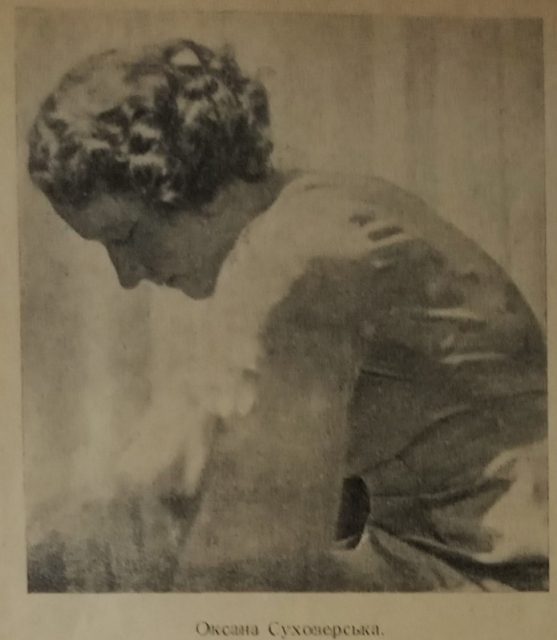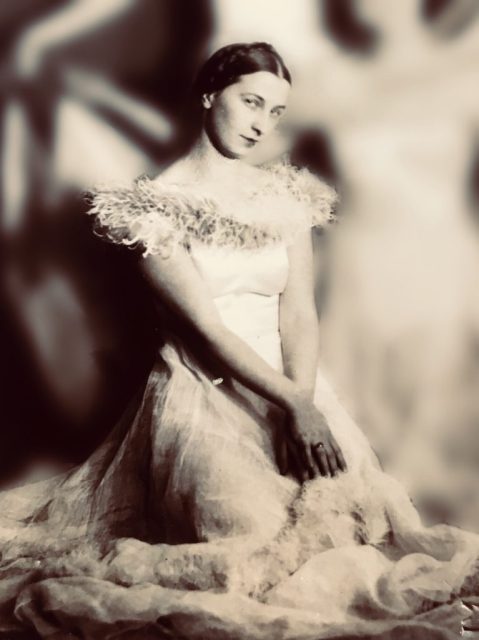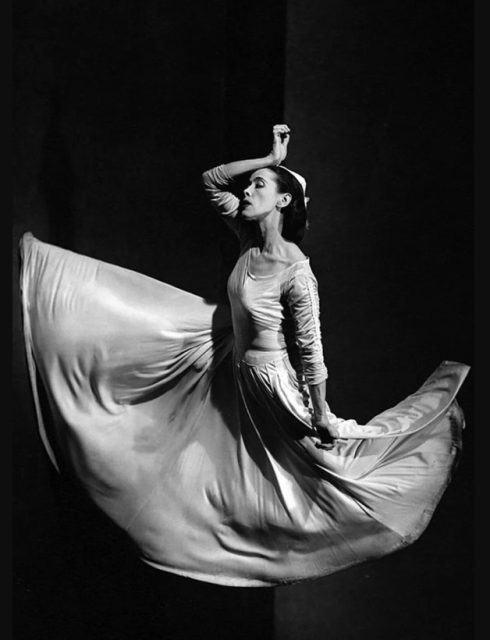The art of dance is inseparably linked with the professionalism of training. The female dancers of Galicia, a vast geographic region spanning what is now western Ukraine, have left their unique mark on the history of modern Ukrainian choreography. Among them, the figure of Oksana Sukhoverska (Fediv), a native of Zolochivshchyna, deserves special attention. She studied piano and completed a private eurhythmics school. Oksana furthered her professional education and skills through courses in Vienna, Berlin, and Prague.
As the pioneer of the women’s Swedish Movement (physical education) in the Galician Ukrainian community, Oksana was not only an adept instructor at numerous women’s educational institutions but also an author of several textbooks. She involved her students in a myriad of creative projects and grand events, such as sports-patriotic gatherings, professional theatre showcases, musical-poetic evenings, demonstrations featuring traditional folk attire, and programs showcasing gymnastic-plastic dances rooted in the eurhythmics of Émile Jaques-Dalcroze’s Swiss system and the free-flowing dance style of Isadora Duncan.
In 1930, she inaugurated the region’s inaugural school of rhythmic plasticity, mainly functioning within the halls of the “Craftsmen’s Community” and the premises of the “Sokil” Society. By 1932, the institution had expanded to include four distinct courses: one for children, two catering to youth, and a dedicated program for women.

Oksana Sukhoverska (Fediv)
Oksana Sukhoverska prepared solo and group dance programs for her younger and older students based on the music of Mykhailo Verbytsky, Ostap Nyzhankivsky, Camille Saint-Saëns, Sergei Rachmaninoff, Franz Liszt, Eduard Schütt, Robert Schumann, Volodymyr Baltarovych, and the poetry of Taras Shevchenko, Lesia Ukrainka, Konstiantyna Malitska, and Yurii Fedkovych. During the early days of the German occupation, Oksana Sukhoverska became part of the “Ukrainian Opera Theater” group as a choreographer. She worked on choreographic compositions for a series of performances that marked the beginning of the creative journeys of several figures in the Ukrainian diaspora’s choreographic art. Some of these figures include Daria Nyzhankivska-Snigurovych, Iryna Sokolovska, actress and choreographer Iryna Zaleska, and Maria Pasternakova, who is known for authoring a series of works on choreography, among others.

Daria Nyzhankivska-Snigurovych
One of her students, Daria Nyzhankivska-Snigurovych, is a Ukrainian choreographer and educator. When Daria was eight years old, she enrolled in Oksana Sukhoverska’s eurhythmics school where she spent ten years studying ballet and gaining a solid foundation of knowledge in the art. She continued to develop her skills under the tutelage of ballerina Mia Slavenska in Prague, at the private ballet school of choreographer Stanislav Falishevsky in Lviv, and with Valentina Pereyaslavets.
In 1939, Daria became the prima ballerina at the Lviv Opera. After emigrating, she opened a ballet studio in a camp for displaced persons in Austria. Her students from this studio were awarded for their composition “A Medley of Ukrainian Folk Dances” at the international dance festival in Innsbruck in 1945.
Daria Nyzhankivska-Snigurovych established her own dance studio in Winnipeg, Canada in 1950. Iryna Zaleska (nee Kobziar), an actress and choreographer, also attended Oksana Sukhoverska’s eurhythmics school during the German occupation and later danced in the ballet of the Lviv Opera Theater. After emigrating, she founded a rhythmic plasticity studio in Mittenwald in 1946. In 1949, she moved to Melbourne, Australia, where she directed and choreographed activities in amateur circles. Zaleska also founded and led a rhythmic plasticity studio at the Ukrainian school in Noble Park from 1962 to 1988, where she taught rhythmic plasticity and artistic speech.
The world of creative achievements belongs to Roma Pryyma-Bohachevska, a Ukrainian dancer, choreographer, and educator. Born in Przemysl, Roma Pryymivna (as she was known in Galicia) was the youngest ballet dancer (from the age of 13) who managed to become a soloist at the Lviv Opera during the transition of the 1930s and 1940s. During the interwar period in Galicia, Ivanna Shmerykovska achieved great success as a professional pianist, cellist, and singer. At the age of eight, Roma enrolled in a rhythmic dance school following the method of Émile Jaques-Dalcroze in Lviv, a private modern dance school based on the Wigman system by Matylda Bronevska, and later joined the ballet studio at the Lviv Opera, where she was taught by Oksana Sukhoverksa, Olenka Herdan-Zaklynska, and Oleg Stalynsky. In 1944, Roma and her mother relocated to Austria. Three years later, she graduated with honours from the Academy of Music and Dramatic Arts in Vienna, where she had attended studios led by Grete Wiesenthal. Roma subsequently became a soloist with ballet ensembles at the National Theaters in both Innsbruck and Salzburg. After meeting choreographer Harald Kreutzberg at his villa in the Alps, she began to focus on the expressionist style of dance, with the aim of revealing the mysteries of the human subconscious through movement.

Roma Pryyma-Bohachevska
Roma Pryyma, accompanied by her mother as the pianist, presented an original program called “Dances and Characters of Ukraine” during a concert tour across cultural centres in Canada, and North and Central America. For five years, they performed in Europe, including cities such as Paris, Munich, Geneva, London and Athens. They also showcased their talent in major cities across the United States and Canada.
After moving to Canada, Roma performed as a soloist in the Royal Ballet in Winnipeg and danced at the theatre of the famous ballerina Ruth Sorel in Montreal. After returning to the United States in 1951, she became an American citizen and settled in New York. There, she joined the famous Martha Graham dance group and also started her own ballet and Ukrainian folk dance schools in New York, Yonkers, and Newark. Her ballet school of Roma Pryyma became well-known for its grand productions such as “Cinderella,” “The Fern Flower” (1970), and “The Adventures of Peer Gynt” (1973).
She skillfully combined classical training with Ukrainian folklore in her unique dance style. She organized summer camps for Ukrainian dance, which were very popular among the Ukrainian diaspora. In 1978, she established the ensemble “Syzokryli” (“The ones with the grey-blue wings”) and assumed the role of its artistic director. It is interesting to note that, unlike traditional national dances where male dancers usually dominate the stage, “Syzokryli” showcases strong, athletic, and agile women.
Bright, modern, initiative-driven, and dedicated women who are committed to the Ukrainian cause, have preserved and carried their uniqueness through all the twists of fate amidst complex political and historical circumstances. They have united the contemporary expressiveness of the dance movement with their national identity, nurturing both the Ukrainian diaspora communities and leading professional ensembles in Europe, the USA, Canada, and Australia.

